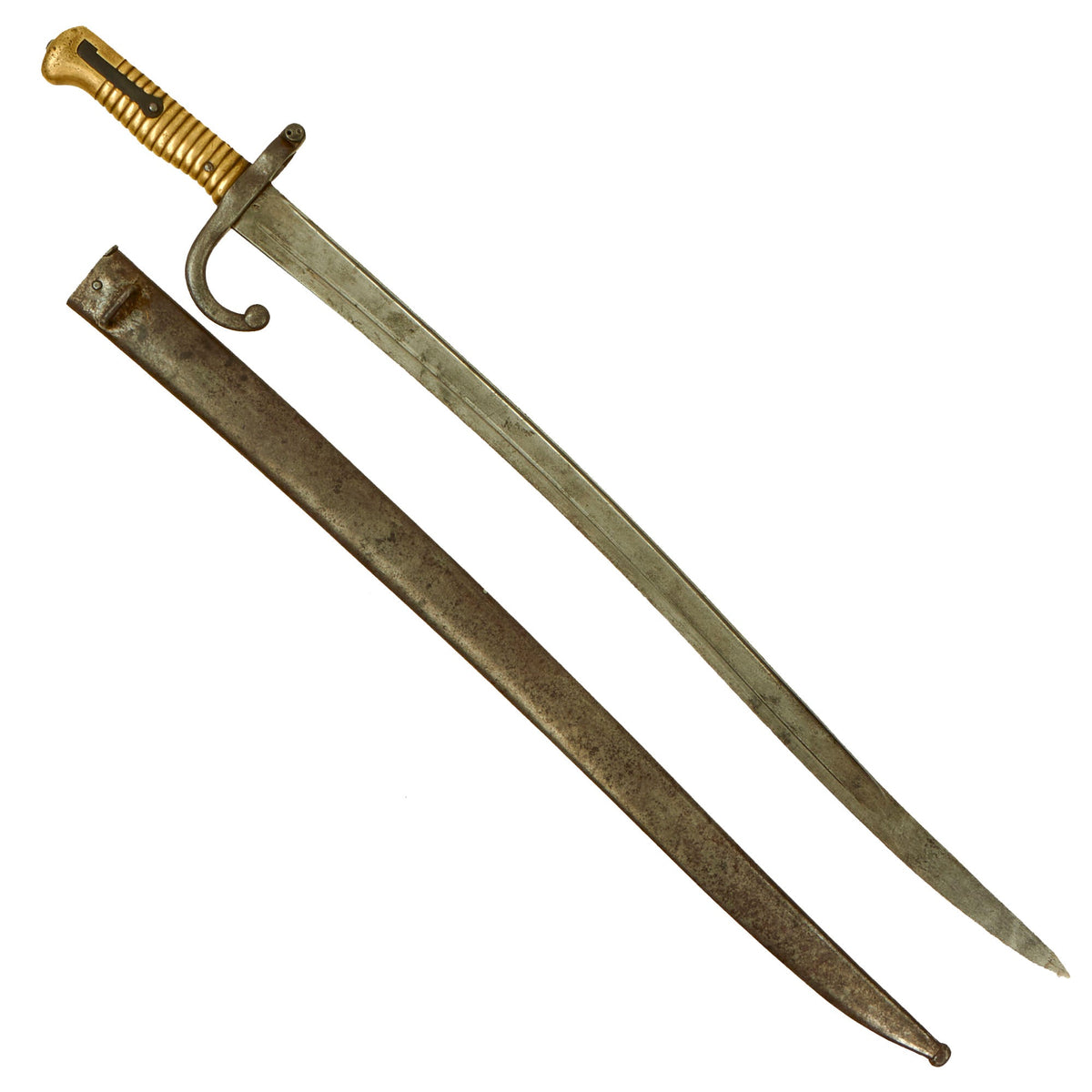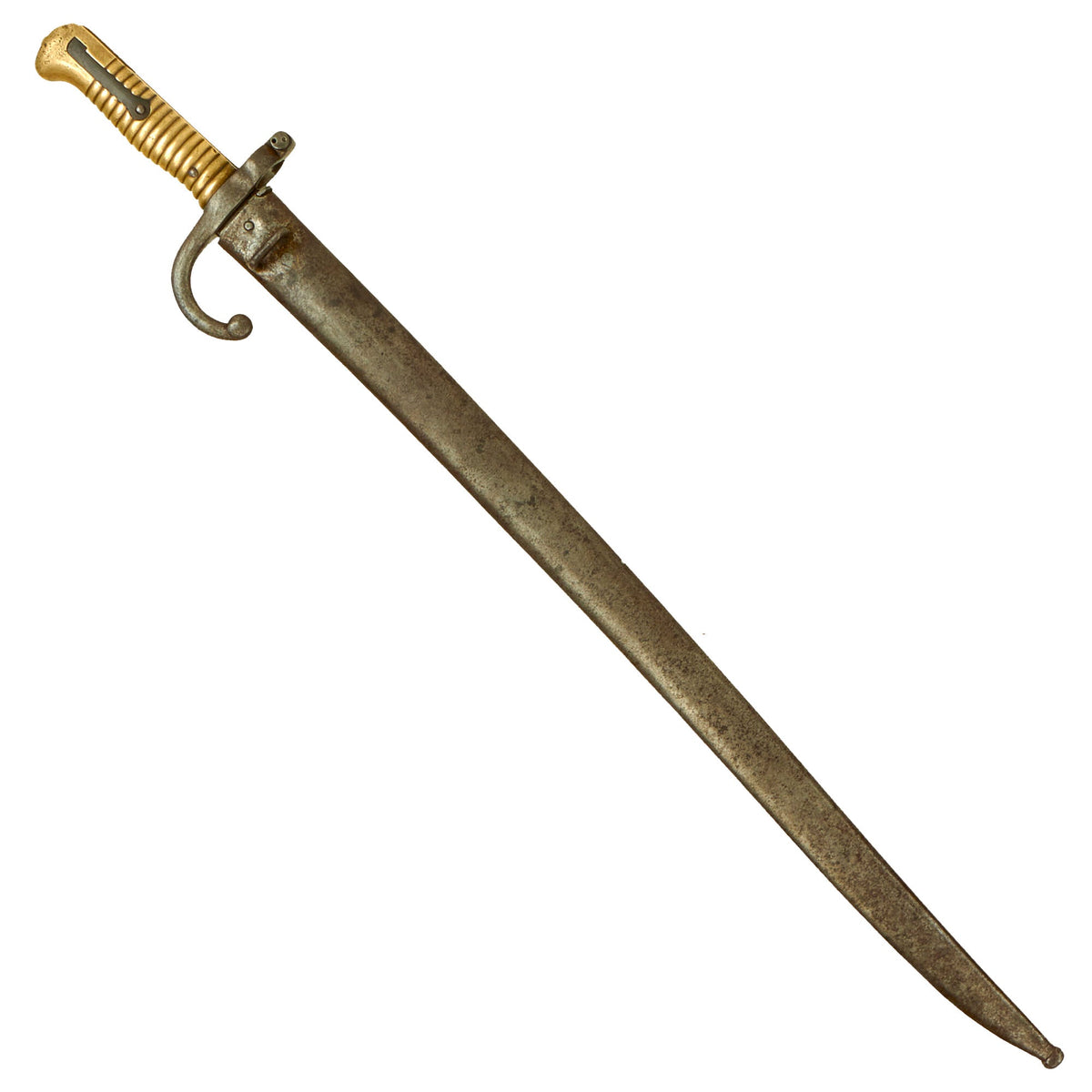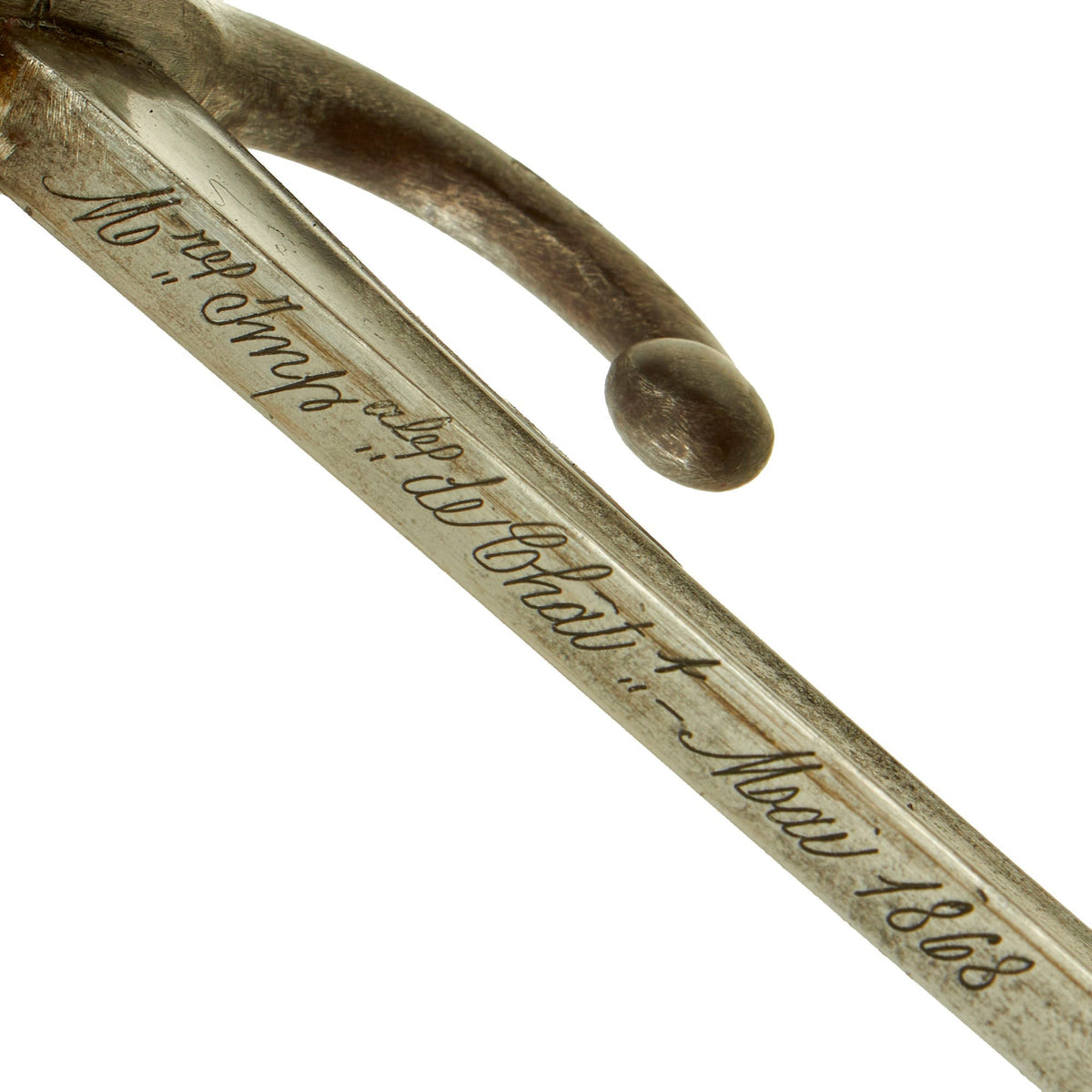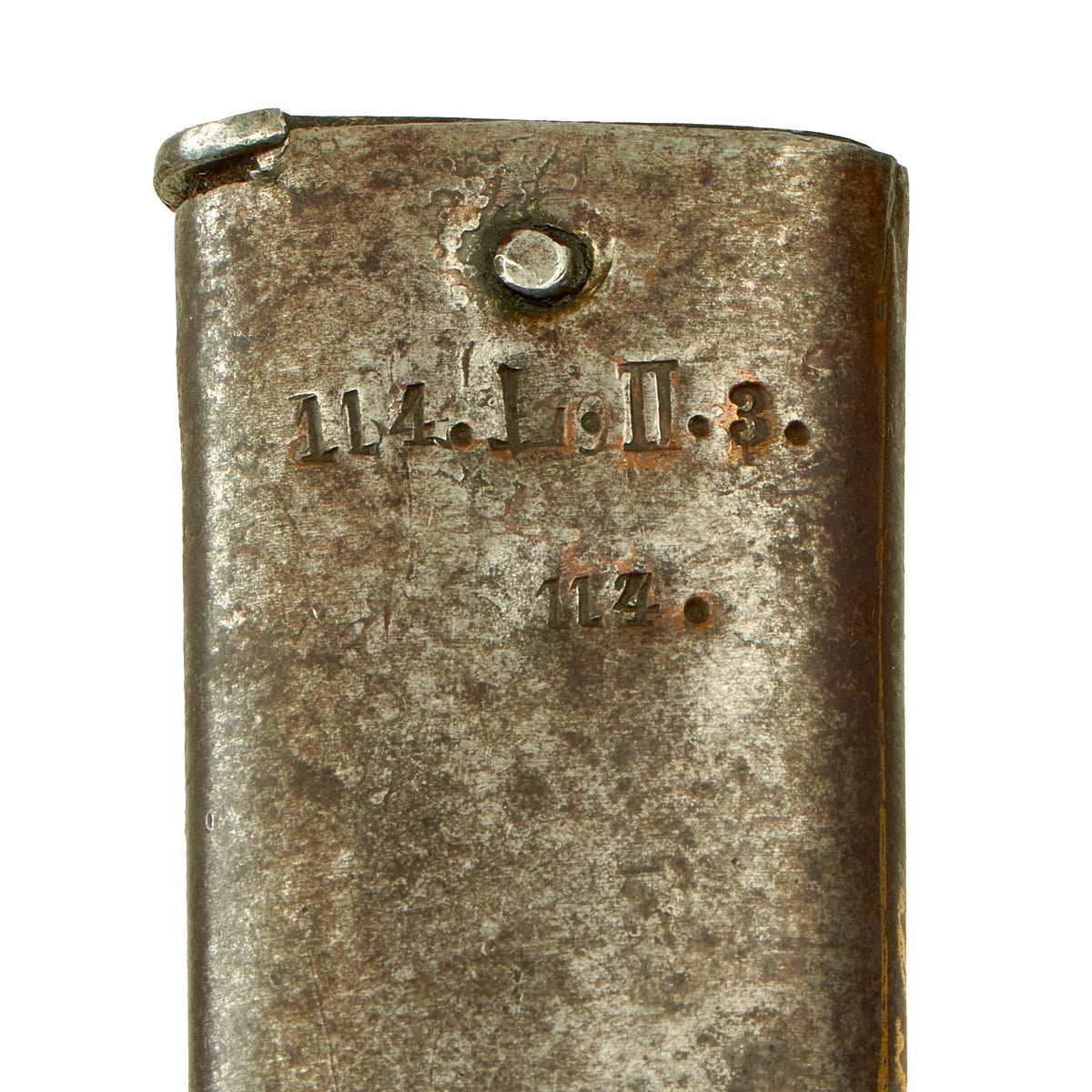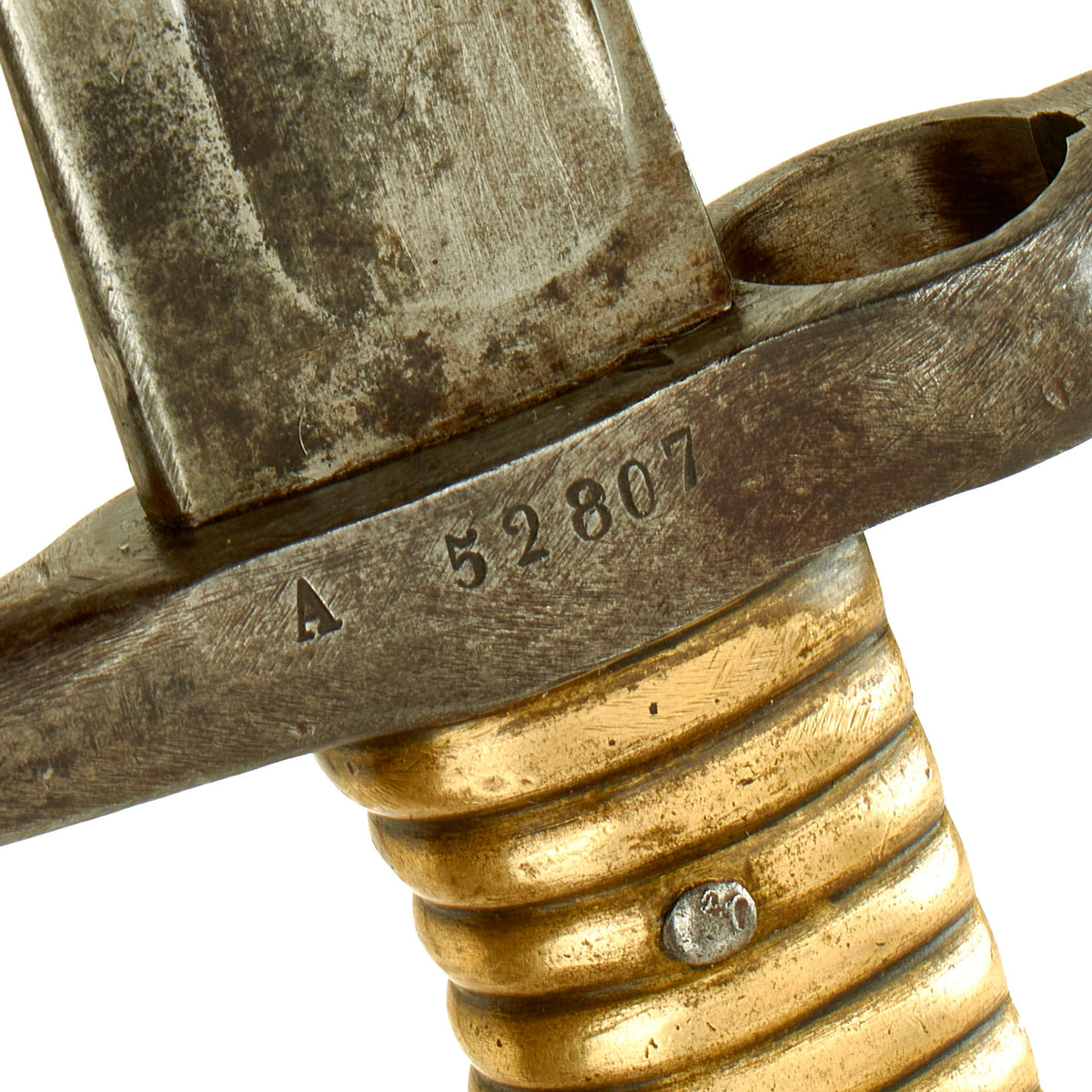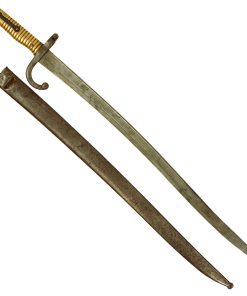Original German Reissued French M1866 Chassepot Saber Bayonet by Châtellerault Arsenal with Scabbard – German Regiment Marked and dated 1868 Original Items
$ 395,00 $ 118,50
Original Item: Only One Available. This is a very nice example of the long “yataghan” saber bladed bayonet for the French Fusil Modèle 1874 “Gras” Rifle, Fusil modèle 1866 “Chassepot” Needle Fire rifle. These were very often cut down or altered later on in their service life, but this example still has the original full length 22 3/4 inch long blade, with an overall length of 27 1/2 inches.
It also has lived an interesting life, as this 1868 dated bayonet was captured after the Franco Prussian War of 1871 and taken back to Germany and reissued for use by German Forces. For reference please see the excellent book GERMAN BAYONETS VOLUME III by J. Anthony Carter pages 209-228.
The original French scabbard still has the “goal post” frog attachment which was often replaced with the typical German long frog stud and the scabbard has been stamped:
114. L. II. 3. 114
This indicates issue to the 114th Landsturm Infantry (Brigade), 3rd Company, 114th weapon.
The spine of the bayonet is marked M’re Imp’ale de Chât’t Mai 1868. This is the abbreviation for Manufacture Impériale de Châtellerault. The Manufacture d’Armes de Châtellerault (“Châtellerault Weapons Factory”), often abbreviated to MAC, was a French state-owned weapons manufacturer in the town of Châtellerault, Vienne. It was created by a royal decree of 14 July 1819 to manufacture swords, then (after 1850) firearms and cannons. Antoine Treuille de Beaulieu in 1840 began to develop the concept of rifled artillery at Châtellerault for the French Army. The Lebel Model 1886 rifle, the first military firearm to use smokeless powder ammunition and the primary French infantry weapon during World War I, was developed and produced here.
It is in very good condition, with a mostly bright blade, with some areas of light staining. The brass handle has a lovely aged mustard patina, and the crossguard has faded to a gray color. The scabbard has lost much of the original black finish, now showing an overall oxidized patina. There are however no major dents or other issues.
A very nice example, ready to add to your Franco-Prussian War Era edged weapon collection or fit to a German Captured rifle!
Specifications:
Blade Length: 22 3/4″
Single Edge “Yataghan” w/ Fuller
Overall length: 27 1/2“
Crossguard: 4”
Scabbard Length: 23″
The Chassepot bayonet was the first of the French saber bayonets to have a hooked quillion. This design feature was quite popular in the late 19th Century, when the bayonet was considered a form of fencing. When parrying the enemy’s thrust, the soldier was to use his own bayonet to deflect the enemy blade and the quillion – like the quillion on a sword – was intended to keep the enemy’s blade from continuing downward; in this case sliding down the length of the rifle to strike the soldier’s left arm and hand holding the forestock of his rifle.
Chassepot
The Chassepot, officially known as Fusil modèle 1866, was a bolt-action military breechloading rifle. It is famous for having been the arm of the French forces in the Franco-Prussian War of 1870–1871. It replaced an assortment of Minié muzzleloading rifles, many of which were converted in 1864 to breech loading (the Tabatière rifles). An improvement to existing military rifles in 1866, the Chassepot marked the commencement of the era of modern bolt action, breech-loading military rifles. The Gras rifle was an adaption of the Chassepot designed to fire metallic cartridges introduced in 1874.
It was manufactured by Manufacture d’armes de Saint-Étienne (MAS), Manufacture d’Armes de Châtellerault (MAC), Manufacture d’Armes de Tulle (MAT) and, until 1870, in the Manufacture d’Armes de Mutzig in the former Château des Rohan. Many were also manufactured under contract in England (the “Potts et Hunts” Chassepots delivered to the French Navy), in Belgium (Liege), and in Italy at Brescia (by Glisenti). The approximate number of Chassepot rifles available to the French Army in July 1870 was 1,037,555 units. Additionally, state manufacturies could deliver 30,000 new rifles monthly. Gun manufacturers in England and Austria also produced Chassepot rifles to support the French war effort. The Steyr armory in Austria delivered 12,000 Chassepot carbines and 100,000 parts to France in 1871. Manufacturing of the Chassepot rifle ended in February 1875, four years after the end of the Franco-Prussian War, with approximately 700,000 more Chassepot rifles made between September 1871 and July 1874.
Fast Shipping with Professional Packaging
Thanks to our longstanding association with UPS FedEx DHL, and other major international carriers, we are able to provide a range of shipping options. Our warehouse staff is expertly trained and will wrap your products according to our exact and precise specifications. Prior to shipping, your goods will be thoroughly examined and securely secured. We ship to thousands clients each day across multiple countries. This shows how we're dedicated to be the largest retailer on the internet. Warehouses and distribution centres can be located throughout Europe as well as the USA.
Note: Orders with more than one item will be assigned a processing date depending on the item.
Before shipping before shipping, we'll conduct a thorough inspection of the items you have ordered. Today, the majority of orders will be delivered within 48 hours. The delivery time will be between 3-7 days.
Returns
The stock is dynamic and we cannot completely manage it because multiple stakeholders are involved, including our factory and warehouse. So the actual stock may alter at any time. It's possible that you may not receive your order once the order has been made.
Our policy is valid for a period of 30 days. If you don't receive the product within 30 days, we are not able to issue a refund or an exchange.
You can only return an item if it is unused and in the same state as the day you received it. You must have the item in its original packaging.
Related products
Uncategorized
Uncategorized
Band of Brothers ORIGINAL GERMAN WWII Le. F.H. 18 10.5cm ARTILLERY PIECE Original Items
Uncategorized
Uncategorized
Uncategorized
Uncategorized
Uncategorized
Uncategorized
Uncategorized
Uncategorized
Uncategorized
Uncategorized
Uncategorized
Uncategorized
Uncategorized
Uncategorized
Uncategorized
Uncategorized
